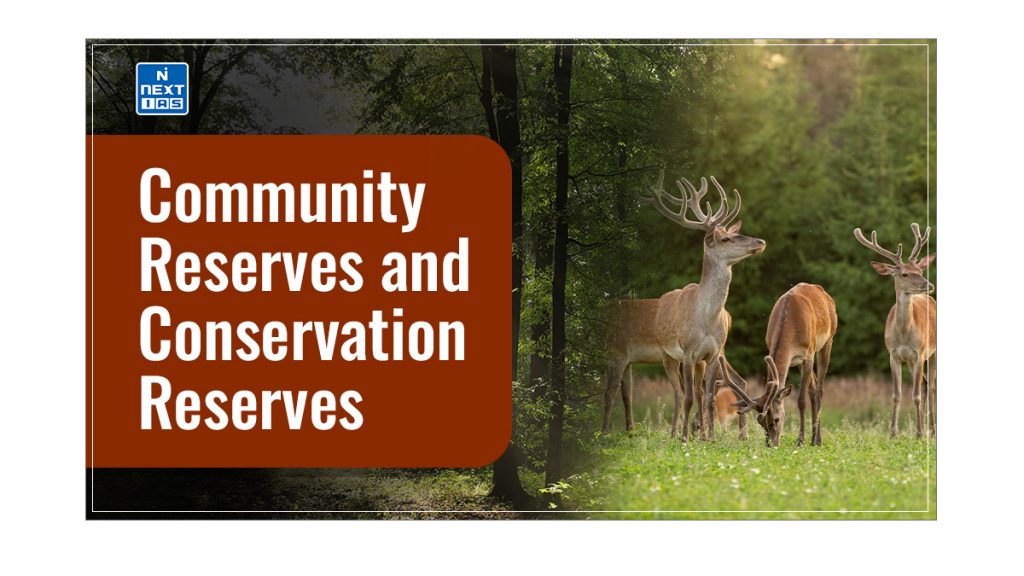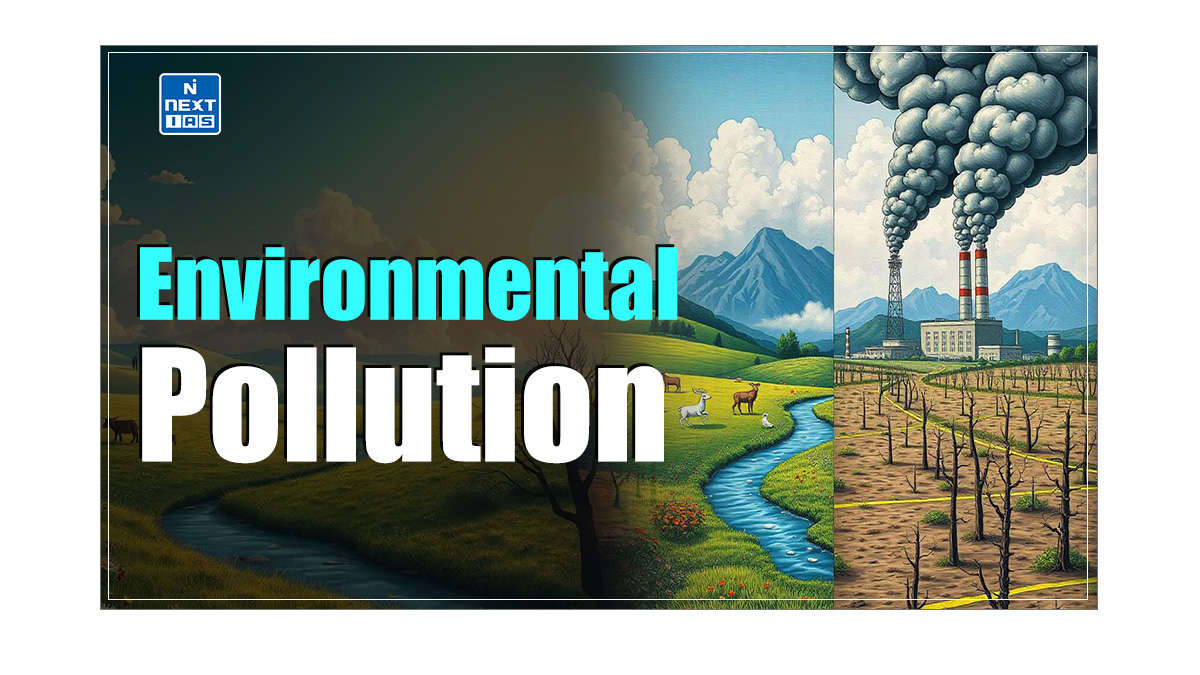
Community and Conservation Reserves are protected areas in India created to involve local communities and private landowners in wildlife conservation. These reserves significantly expand the country’s protected area network while fostering sustainable use of natural resources. This article aims to study in detail the objectives, significance, and challenges of Community and Conservation Reserves in India.
What are Community Reserves?
- Community Reserves are designated areas that recognise the significant role local communities can play in wildlife conservation.
- These reserves are created on lands that are either privately owned or under community control.
- The ownership remains with the people or community, and their involvement in the management and decision-making processes is key to maintaining the area’s ecological balance.
Examples of Community Reserves
- Some of the well-known community reserves include areas in Meghalaya, Nagaland, and other Northeastern states of India, where local tribes and communities have traditionally played a role in conserving their ecosystems.
Key Features of Community Reserves
- Ownership and Management: The landowners or the community have the authority over the land and participate actively in the conservation efforts. The government provides a framework and technical support, but the community plays a pivotal role.
- Voluntary Involvement: Community Reserves are established voluntarily by communities that are keen on conserving their local biodiversity. It encourages local stakeholders to take pride in preserving their environment.
- Biodiversity Protection: While the primary goal is wildlife conservation, these reserves also help protect various plant species, and natural habitats, and maintain ecological balance.
- Sustainable Use of Resources: Local communities are allowed to use certain resources sustainably, ensuring that the conservation measures do not adversely affect their livelihoods.
- Legal Backing: Under the Wildlife Protection Act (1972), the government gives legal recognition to such areas, ensuring that wildlife and ecosystems within the reserves are protected from destruction, poaching, or other harmful activities.
Significance of Community Reserves
- Empowers Local Communities: By allowing local people to manage their lands and resources, Community Reserves foster a sense of ownership and responsibility towards conservation.
- Biodiversity Conservation on Private Land: Community Reserves help bring privately owned lands under the conservation fold, ensuring that important biodiversity areas outside government-controlled parks are also protected.
- Livelihood Coexistence: These reserves allow the coexistence of wildlife conservation and sustainable livelihood practices, such as traditional agriculture or handicrafts.
What are Conservation Reserves?
- Conservation Reserves are protected areas created on government land that serves as corridors or buffer zones between established national parks, wildlife sanctuaries, or other protected regions.
- These reserves are designed to conserve habitats and wildlife while providing space for sustainable human activities.
Examples of Conservation Reserves
Some of the notable Conservation Reserves include the Kutch Desert Wildlife Conservation Reserve in Gujarat, which acts as a buffer zone for the Indian Wild Ass Sanctuary, and various reserves in states like Karnataka and Maharashtra.
Key Features of Conservation Reserves
- Government Land: Conservation Reserves are established on lands owned by the government. The government is responsible for their legal designation and protection.
- Corridors and Buffer Zones: These areas often function as ecological corridors, allowing the movement of species between larger protected regions. They can also act as buffer zones, minimizing human-wildlife conflict in areas adjacent to national parks or sanctuaries.
- Stakeholder Involvement: Though the government owns the land, local communities, stakeholders, and conservationists are actively involved in the decision-making and management processes.
- Wildlife Habitat Protection: Conservation Reserves focus on protecting habitats that are crucial for the survival and migration of species, particularly those that move across large areas, such as elephants or big cats.
- Limited Human Activity: Human activities are regulated to ensure that they do not negatively impact the wildlife or the natural habitat. However, eco-tourism, scientific research, and certain sustainable uses may be allowed.
Significance of Conservation Reserves
- Habitat Connectivity: One of the major challenges in wildlife conservation is habitat fragmentation. Conservation Reserves provide critical corridors for species migration and genetic exchange, ensuring long-term survival.
- Buffer Zones: These reserves act as protective buffers around core wildlife areas, reducing human-wildlife conflict by maintaining a safe zone for both wildlife and local communities.
- Increased Protected Area Coverage: Conservation Reserves help expand the network of protected areas beyond just national parks and wildlife sanctuaries, thereby increasing the overall space dedicated to biodiversity conservation.
Importance of Community and Conservation Reserves in Biodiversity Conservation
- Biodiversity Preservation: India is home to a rich variety of ecosystems and species, many of which are threatened by human activities.
- Community and Conservation Reserves are crucial in preserving biodiversity, especially in areas outside traditionally protected zones like national parks and sanctuaries.
- Community Engagement in Conservation: Conservation is most effective when local communities are involved. Community Reserves empower indigenous and local populations, ensuring that conservation goals align with their cultural practices and livelihoods.
- By fostering cooperation between the government and local communities, conservation efforts become more sustainable and inclusive.
- Wildlife Corridors and Conflict Mitigation: Conservation Reserves are vital for maintaining wildlife corridors that allow the free movement of animals, ensure genetic diversity, and reduce inbreeding.
- They also help in mitigating human-wildlife conflict by creating buffer zones between core protected areas and human settlements.
- Cultural and Ecological Balance: Both Community and Conservation Reserves protect not just wildlife but also the cultural heritage and traditional practices of the communities living around these areas.
- These reserves help preserve the intricate balance between human activity and ecological sustainability.
Challenges in Managing Community and Conservation Reserves
- Lack of Awareness: In many regions, the concept of community and conservation reserves is still relatively new, and local communities must be aware of the benefits and responsibilities associated with these reserves.
- Conflict of Interest: In some cases, conflicts may arise between conservation objectives and the livelihood needs of local communities. Striking a balance between sustainable resource use and biodiversity protection can be challenging.
- Insufficient Funding and Resources: Managing these reserves requires adequate funding, resources, and technical support. Often, both Community and Conservation Reserves struggle with limited financial assistance from the government or external agencies, affecting their overall effectiveness.
- Encroachment and Illegal Activities: Encroachment by human settlements and illegal activities like poaching or logging can pose significant threats to these reserves. In Community Reserves, enforcing regulations can be more difficult due to private ownership or community control.
Conclusion
Community Reserves and Conservation Reserves represent a progressive approach to wildlife conservation in India by involving local communities, private landowners, and other stakeholders in managing and protecting biodiversity. These reserves help expand the country’s network of protected areas and foster greater harmony between humans and wildlife. Despite the challenges, they hold immense potential in safeguarding India’s ecological wealth while ensuring that local communities benefit from sustainable conservation practices. Community and Conservation Reserves can significantly contribute to India’s conservation goals for future generations with continued government support, stakeholder participation, and public awareness.
Difference between Community Reserve and Conservation Reserve
| Aspects | Community Reserve | Conservation Reserve |
|---|---|---|
| Meaning | A protected area aimed at conserving biodiversity and resources while allowing local communities to engage in sustainable practices. It often recognises and supports the rights and livelihoods of indigenous or local people. | A designated area primarily focused on protecting wildlife and natural habitats. It may have stricter human activity regulations than community reserves and typically prioritises ecological conservation. |
| Purpose | It aims to balance conservation goals with local populations’ social and economic needs, promoting sustainable livelihoods. | It primarily focuses on conserving ecosystems and wildlife, often intending to preserve biodiversity for its own sake. |
| Management | It is managed with active participation from local communities, ensuring their traditional practices and knowledge contribute to conservation efforts. | It is managed by government or conservation authorities, often with limited input from local communities, focusing on scientific conservation methods and biodiversity preservation. |
| Regulations | It may allow local communities to use resources more flexiblely, as long as it aligns with conservation goals. | It generally enforces stricter regulations on land use, resource extraction, and human activities to protect ecological integrity. |
| Examples | Areas that allow local communities to sustain the harvesting of forest products while also protecting critical habitats. | National parks or wildlife sanctuaries with limited human activity to protect endangered species and habitats. |






